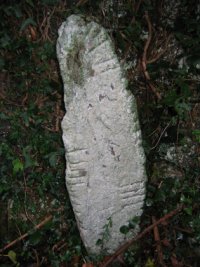
Ancient Stones
Ireland also has plenty of stone. Many stones speak of Ireland’s ancient past, as we see by the many megalithic tombs, stone circles, barrows and standing stones all over the landscape. Many others have attracted criticism of its Chrstian past.
Bullaun stones appear all over Ireland. They are recognisable as cup-shaped hollows in stone. They are found in Atlantic Europe, and elsewhere and are generally thought to go back to the Bronze Age. These stones vary considerably in size and sometimes there may be many ‘cups’ in one stone. It has to be said very clearly that, in the absence of virtually any literary reference, no one knows what their purpose was. However, because they go back so far and many are found on Christian sites, their use has been keenly discussed. Some say that they were meant to hold water, some for use in grinding; others view them as holding offerings to the ‘gods’. But the ‘container’ theories have to explain why some of them are worn right through well beyond their capacity to contain anything.
Rounded river or sea stones are sometimes found in these bullauns. They are also found on some altars. Such stones are prayer-stones. At Killinagh Co Cavan, located near a church and holy well there is one large boulder with nine bullauns, with others to the side, and there are round stones in all of them. As one prayed they were turned in a clockwise direction. Some such stones, for example at Inishmurray (Co Sligo), have crosses marked on them. Herity believes that the practice of using stones for prayer was taken over from earlier times and that the making of the hollow bullaun stones was due to such turning. This explanation ought to be heard though it goes against the grain of current assumptions. There is some evidence that these stones have been called cursing-stones, when they were turned in an anti-clockwise direction. But this may be a debased and later perception. They were used for prayer, and indeed still are.
Some stones were deemed to have healing powers. This follows from the belief that the stone had been blessed by the saint – just as even the shadow of an apostle could heal. There are also ‘stones’ which have been connected with saints more personally, marks which look as though they are foot marks, finger marks, or knee marks where the saint is thought to have knelt in prayer. At first such beliefs seem pathetic. But, as we have already seen, this was all about the connection between a saint and a locality and this meant so much. There are also saints ‘beds’ usually in the form of a lengthy piece of stone on which a pilgrim could lie as he sought the saint’s prayers. Again, it is easy to scoff. But there is a very interesting detailed account of such a healing at the tomb of St Peter of Korish at Crna Reka in Serbia in recent years.1
Other stones were used as ‘swearing stones’ in much the same way as a bible is used to swear an oath. In the days when there was little enough security by which to seal an agreement or get redress when it was broken it was not an empty hope that respect for the local saint might work better than anything else.
There are holes in some stone crosses. These might be explained as pagan stones converted into crosses. On some crosses a face, or even a weird figure, appears on the reverse. These too might be re-used stones; or affirming Christ’s humanity? or his victory? But what of seemingly phallic stones? Or pairs of possible fertility stones? Again nobody knows. Imaginations run riot. So much is to do with the expectation in the minds of the person who sees them. And lastly the sheela-na-gigs, or figures of women who expose themselves? Nobody knows. Were they to warn monks of the dangers represented by women? Or were they used, often out of sight high up on walls, to ward off evil-spirits? Finally, do we have an idol? Two strange figures sit in the Caldragh graveyard on Boa Island in Lower Loch Erne Co Fermanagh. Again nobody knows.
All these stones give some idea of the intriguing phenomena of ancient Ireland. We have to be content to be puzzled. But we must also be on guard against assumptions that would deny Ireland’s Christian past. Thus while white quartz and sea scallops had a symbolic meaning in prehistoric times, in a Christian context the meaning of both was dominated by belief in the Resurrection.2
Finally there is Ogham. This was a script used in the 5-7 centuries mainly in the south and west of Ireland using twenty characters cut across the edge of an upright stone. They often commemorate a deceased person – their function therefore is very limited. The great antiquarian Macalister thought them pagan. But while some stones are pre-Christian, the script carved on them may well belong to the Christian period. This once more manifests a confidence in the new order of things from a clearly early date. A similar sign of awareness of change might be seen in the inscribing of crosses on ancient tombs, standing stones, and pillar-stones. However it is impossible to say when the inscribing of such crosses was made. Some however will be ancient.
1 http://www.kosovo.net/miracle.html
2 The Book of Revelation says that a white stone is given to each who inherits eternal life. The scallop shell symbol was placed over Christ’s tomb in the Church of the Resurrection Jerusalem. See Marshall and Walsh Illaunloughan Island ch 6 ‘White Quartz, Scallops and Shrines. (Bray: Wordwell Books 2005)